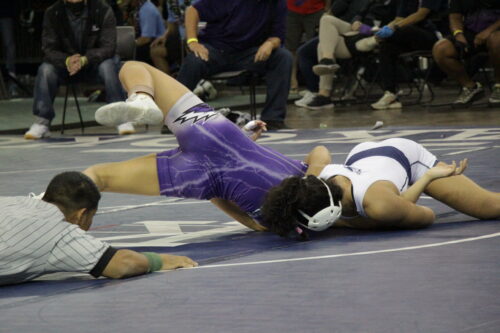Starting in the 2023-24 season, state associations across the country will be able to choose boys and girls wrestling competition based on either 12, 13 or 14 weight classes.
Presently, the National Federation of State High School Associations recommends that all states use 14 weight classes and Hawaii does that.
 Kamehameha’s Haley Narahara closed in on a pin of Pearl City’s Taydem Uyemura in the 122-pound girls state championship final in March.
Kamehameha’s Haley Narahara closed in on a pin of Pearl City’s Taydem Uyemura in the 122-pound girls state championship final in March.But will Hawaii change its format to 12 or 13 classes when the 2023-24 season begins?
The quick answer is: doubtful. But the guess here is that the question will be discussed at the Hawaii Interscholastic Athletic Directors Association annual meeting in either or both of its late spring conventions in 2022 and 2023.
Bedrock Sports Hawaii reached out to three coaches and one administrator in the Hawaii high school wrestling community to find out what they would like to see happen and why.
All but one responded that they overwhelmingly prefer to keep it at 14 classes.
The other one — former Aiea coach and longtime organizer Rick Williams — sees the benefit of decreasing the number of divisions temporarily due to a drop in the amount of competing wrestlers in the COVID-19 era, but he isn’t necessarily in favor of that course of action.
“I can see both sides,” Williams said. “If you decrease the weight classes, it takes forever to get them back, even if participation improves. On the other hand, now there are many weight classes that have so few wrestlers. The athletes just don’t get enough matches to make them competitive for postseason tournaments. I think fewer weight classes will give the athletes more opportunities for matches, which will improve postseason competitions.
But there needs to be some kind of annual evaluation that would make it possible to automatically increase the weight classes the following year. I was disappointed with the level of the competition at this year’s state tournament. And some of our champions didn’t do as well as they should have in national events, which is a good indicator of where our abilities are now. Not enough local completion has a lot to do with that.”
The next three who were asked for their opinions all prefer keeping the number of divisions at 14.
“I am 100% in favor of keeping 14 weight classes,” Kalani coach Racer Moody said. “While going down to 12 in times of low numbers may seem good to boost competition, it actually takes away opportunities for more students to wrestle. Going from 56 down to 48 starting spots (JV and varsity boys and girls) wouldn’t help the sport, I think. Even though some of our kids, especially on the JV level, may be winning a championship or even placing in a smaller bracket right now, it goes a long way in building their confidence for the future. For some, it might be the first time they are ever successful at anything.”
Moody continued by acknowledging why some people might like 12 weight classes:
“I’m sure smaller teams would prefer 12 because it would give them a better opportunity to vie for a team title, but those coaches just need to do a better job of marketing the sport to their school’s respective students, myself included. In football, when a school can only field a team of 20 players or less, they don’t get to petition the league to make it a 9 vs. 9 game. I know my team has never filled out all 14 weight classes, but I enjoy the challenge of trying to do so. We got close this past year, filling out 12 of 14 on the varsity boys side, even though it included four first-year wrestlers. All three of my first-year sophomores even had the opportunity to qualify for the state tournament because of the low numbers. That opportunity was unforgettable for them and is something that hooked them into the sport for good. Two of those sophomores even won a match at states.
And Moody offered another reason for keeping the status quo
“I am in favor of keeping the alignment of our weight classes with the national federation weight classes because it gives our wrestlers the chance to be recognized nationally — apples to apples — with wrestlers from other states.”
Moanalua coach Lucas Misaki and Kapolei coach Sean Salter also believe fewer weight classes would not be good for Hawaii.
“I’ve talked to a lot of coaches and they do not want to reduce our sport down to 12 weight classes,” Misaki said. “Most of us understand the long-term detrimental effects of shrinking our sport. If you look at the raw numbers, our state tournament could drop down from potentially 560 wrestlers to 480 (28 weight classes multiplied by 20 entrants compared to 24 x 20). State placers would drop from 168 medalists to 144. It won’t just affect the bigger teams and bring them back to the crowd, it’ll hurt the smaller teams, too. I’ve wrestled and coached at small programs and large programs and I’ve seen teams building momentum year to year from just a few placers. The loss of 24 total boys and girls placers may or may not be distributed evenly across the five leagues and programs of all sizes. Building any program, big or small, requires momentum through concrete evidence that success is possible.”
Misaki got creative with more of his reasoning:
“Weight cutting is still a thing in this sport and reducing weight classes is basically two parts of a crap sandwich and someone has to take a bite — either cut more weight or go to the next highest weight class and give up size and strength. Neither are healthy choices.”
Salter was confident in his assessment that the OIA — one of the five leagues in the state along with the ILH, BIIF, MIL and KIF — will not support eliminating weight classes.
“The OIA definitely isn’t supporting weight changes, but there are a few things to consider,” he said, before giving his talking points:
>> “More weights means more opportunities. Less weights means less. That alone should make it hard to reduce to 12 from 14.”
>> “If they take away weights even for one year, it becomes very difficult to get them back. Once you lose anything, the state begins to think you can do without it.”
>> “Having less weights makes it so smaller schools can compete better with larger schools because you don’t need to fill as many weight classes. But since duals aren’t a major component of the season, then having more weights doesn’t weigh as much on smaller schools until the end of the season.”
Listed below are boys and girls weight classes presently as well as the NFHS’s recommendations for 2023-24.
>> Hawaii boys weight classes presently: 106, 113, 120, 126, 132, 138, 145, 152, 160, 170, 182, 195, 220, 285
>> NFHS recommendations for boys weight classes in 2023-24: 106, 113, 120, 126, 132, 138, 144, 150, 157, 165, 175, 190, 215, 285
>> *-Hawaii girls weight classes presently: 97, 102, 107, 112, 117, 122, 127, 132, 138, 145, 155, 168, 184, 225
>> NFHS recommendations for girls weight classes in 2023-24: 100, 105, 110, 115, 120, 125, 130, 135, 140, 145, 155, 170, 190, 235.
—–
*-Hawaii girls weight classes don’t match the NFHS guidelines presently.
—–
ALSO AT BedrockSportsHawaii.com:
BEDROCK’S VIDEO- AND PHOTO-PALOOZA From The Texaco/HHSAA Wrestling State Championships


